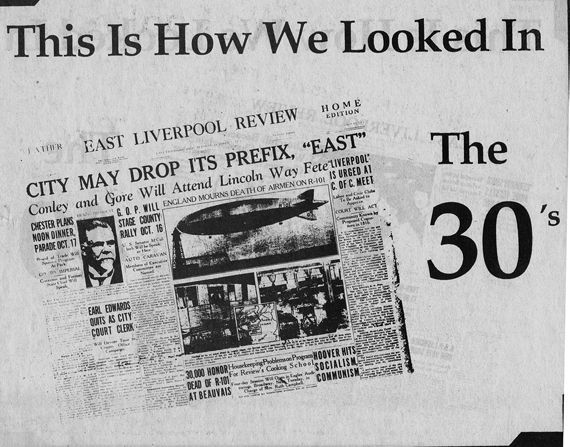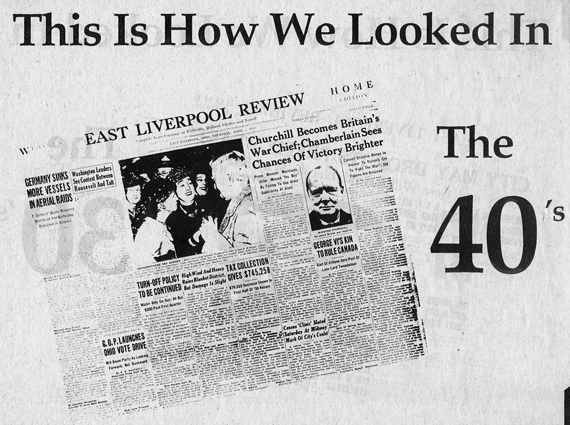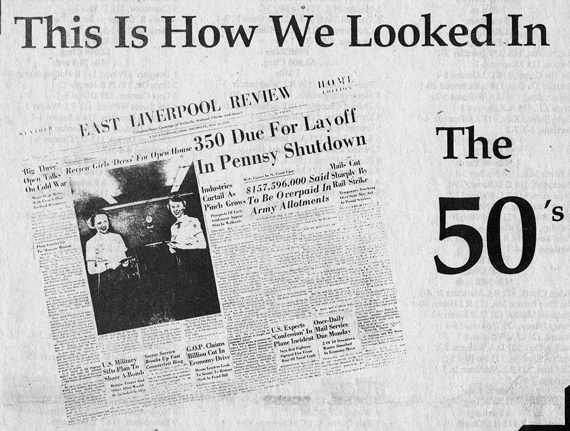| Chapter VI, A Brief History of Newspapers in East Liverpool, Ohio, by the late Glenn H. Waight, former editor of The Evening Review. |
CHAPTER VI
The 'Review' Years
The East Liverpool Review along with most other newspapers struggled through The Depression years and later the shortages of staff and supplies during World War II. Charles Victor Hughes, a Canton native, held the leadership reins during those trying times
Short, stout and bald, genial "C.V." had come to the paper in 1928 after Thomas Brush left for New York. He not only guided the daily through the dark Thirties and Forties but for the move into a new Fourth St. building.
Vic started his newspaper career as a 12-year-old newsboy selling The Repository. He attended Mount Union College, and was commissioned a second lieutenant in infantry in 1918, serving at Camp Grant, Ill., until discharged in 1919.
He worked in the "Rep" mailing room, newsroom and advertising department, and when Brush-Moore bought the Canton paper in 1927, he became credit manager, then assistant business manager.
When Thomas Brush departed The Review, Vic replaced him as business manager which entailed supervising the whole operation -- news, advertising, printing, press crew, circulation, maintenance and public relations. The designated publisher and executive editor for the chain's papers were in Canton, but the day-by-day operation rested with the local business offices.
Vic had to deal with a diversity of talents and personalities. Most of the staffs were of the old school, down to earth and direct, many almost stereotypes of Hollywood style reporters, printers, pressmen and ad salesmen. Countless tales were passed down of both humorous and sorry incidents in the crammed halls of the old building on Washington St. and out in the town.

Department heads included Harvey Nelson in the press room, Walter Niblock of the composing room, Ralph Deshler in circulation and classified advertising and George A. Shaw of display advertising. An important figure was custodian Steve Burlingame who lived in a top floor apartment with his wife. Leathery-faced Steve maintained a farm near New Waterford, and in season brought tomatoes and other fresh vegetables for appreciative employees.
IN THE NEWSROOM were society reporter Sarah Gardner Vodrey, news reporters Howard "Scoops" Kaufman, Bob Popp and Byron Eells, city editor Paul Walton, sports editor Bob Shaffer, and wire editor Arthur "Toots" Thomas.
The nationally popular Saturday Evening Post magazine used photographs of the interior of The Review in May 1937 to illustrate a story about the travails of the small town editor. Written by Mark Rhea Byers, it compared the almost anonymous reporters and editors of metropolitan papers to the staffs of dailies in small towns and cities who were familiar to almost all their readers.
Titled "I Want To See The Editor," the article described how citizens demanded to have their items published or sought to suppress news which would embarrass them or their families. Advertisers were seen as particularly demanding. The head of one chain of papers was reported to have placed a notice in editorial departments reading, "Whatever a patron wants to get published is advertising. Whatever he wants to keep out of the paper is news."
Two photos of The Review symbolized the small town paper. One showed the lobby and want ad department of the Washington St. building crowded with newsboys picking up their deliveries. This was captioned "Front Office of a Superior Small Town Newspaper, The East Liverpool, 0., Review." The second photo was of the composing room with printer Johnny Moore and foreman Walter Niblock working with an editor -probably Ernie Fisk -- making up a page. They were not identified in captions.

In addition to his managerial duties, Vic Hughes was also kept busy around town, serving at various times as president of the Rotary Club and YMCA board, director of the Chamber of Commerce and trustee of City Hospital.
He filled the traditional role of publisher, taking a leadership role in community and business world, using his influence to advance important causes. His broad contacts enabled him to learn of key stories and newsworthy trends, or on occasion to divert or delay reports of some developments outside the normal news channels.
The editors also were involved in organizations and campaigns, their public relations skills and knowledge of the community helpful to good causes.
Vic Hughes retired from The Review in 1962, and for a while taught school to keep active. His wife became ill, and the pair moved to North Canton where she died. He later went into a Cleveland nursing home and passed away in 1970.
AS YOUNGER MEN left for military service, women were hired to replace them. The late Bob Popp recalled some of the females who came to the newsroom. His City Hall post was divided into two jobs -- one for Zenith Henkin who covered the Mayor's office and other municipal areas, and the second for Howard Kaufman, a World War I veteran. He visited the police headquarters and courts where some news developments might have been too coarse for a genteel woman reporter.
Lucille Cox, who had written features for some time, was pressed into duty at the state editor's desk, Betty Manley wrote nothing but countless servicemen's items, and Betty Weir (later Homolya) was primarily a feature writer.
Besides Popp, Al Foutts, reporter-photographer, served in the military during the war.
Many women had previously worked as printers at The Review back in the 19th Century. When the East Liverpool Typographical Union No. 318 was organized May 15, 1892, in a meeting at City Hall, two females were among the 13 charter members -Bessie Brandon and Celia Cobegan.
Bessie Hanley Patterson had been a printer's "devil" (apprentice) when McCord started his News, and she served out her apprenticeship at the Review.
A printers contest was held at the paper in December 1895, with compositors given 4% hours to set Brevier type, leaded with 6 to pica leads on news manuscript and `takes' run of the hook. Bessie Hanley, her last year as apprentice, won with 7,680 ems. Others were C. W. Brownfield 7,469, Criss McConnell 7,460 and J. T. Herbert 6,620.
While I was at the paper, Evelyn Ludwig Sanders was the only Review "hot lead" female printer, although telepunch operators Ann Volino, Mary Curtis and Daisy Vucinich belonged to the typographical union. After photocomposition replaced the old lead casting equipment, many more women were employed.
Proper preservation of The Review's editions, dating back to 1879, was a concern solved in 1948 with copying all of the past papers onto 35 millimeter film. Earlier newspapers were printed on rag content paper which resisted deterioration. But later on, the more economical wood pulp newsprint was used, and it tended to turn brown and crumble with age.
Not only were past Review's copied onto the rolls of film, but The Mercury, The Crisis, The Tribune, The Potters Gazette and some copies of Wellsville and Salineville papers were placed in the files in the Recordak system. The old copies of the Mercury and Tribune were bought by the city Historical Society in 1925 from Jere Simms' widow, Virginia. Atty. W.H. Vodrey and H. B. Barth, Society secretary, arranged the purchase.
With three months of papers or 1,200 pages reduced to one 100-foot roll, the space required to store big bound volumes in an overflowing 12-square foot room was converted to a cabinet about four feet tall.
Duplicates were made of all the film for the Historical Society and placed in the Carnegie Public Library which also took custody of the no longer needed bound volumes. When the many bound volumes jammed the Library, they were relocated to the Museum of Ceramics.
LATE IN THE 1940S, Brush-Moore leaders decided to invest in a major construction and modernization program at the older newspaper plants.
First a new facility was built for the Salem News, completed in 1949. Next, in 1950, was one for The Review at East Liverpool, a one-story brick and terra cotta structure on East Fourth St. a half block away from the old converted bank building occupied for 55 years on Washington St.

The new site, consisting of two full lots and part of a third, was bought in 1947 from Don F. and W. Howard Smith. On the tract were four houses -- two on Fourth St. and two on Church Alley -- and three business storerooms.
The new $400,000 art deco plant, featuring a shiny stainless steel entrance, extended 106 feet along Fourth St. and 115 feet back to Church Alley. Two new 16- page Goss Unitubular presses were installed at a cost of some $150,000 in the basement. Two new Linotype machines were also purchased, and one of the first fluorescent lighting systems in the area brightened the interior.
Architect James William Thomas of Hudson had designed the building, one of several over 20 years, including that of the Pittsburgh Press, New York World Telegram and the Rochester, N.Y, Times-Journal.
The architect pointed out the structure provided for expansion of all departments, incorporating moveable partitions. Few journalism visionaries then saw the approach of computer technology that would greatly reduce the need for space to accommodate large and heavy equipment with many employees.
Another purchase was that of the Moose Lodge building adjacent to the newspaper at the corner of Fourth and Washington. This was the original brick Wells Building erected in 1890 and the home of The Review from 1892 until 1896 when it moved to Washington St. The lodge constructed a new home on Third St., and the old structure was razed to create a parking lot for Review employees.
An estimated 3,000 toured the new plant May 12-13 with the two city radio stations -- WOHI and WLIO - recording the proceedings on tape for re-broadcast. Women employees in newspage design dresses greeted visitors at the door, and handed out 24- page brochures that featured many photographs and explained the new operation.
In June, The Review and The Salem News played hosts to some 100 Ohio editors, publishers plus advertising and circulation executives transported by chartered buses to visit the two new facilities.
In order to provide a bond among the many employees of the chain, a small bimonthly magazine was published at Canton and distributed to the newspaper and radio station staffers. It was started in 1948 under the direction of Helen Carringer of The Canton Repository, with correspondents at each site contributing articles and photos.
This magazine was called "The Typocycle," and featured reports and photographs about chain personnel and policy changes, new equipment along with promotions, social events, birthdays, deaths, anniversaries and other items about each daily, weekly and station,
Brush-Moore continued to prosper after the death of the three founders, and G. Gordon Strong, a leader in the newspaper field, became president and publisher.
This site is the property of the East Liverpool Historical Society.
Regular linking, i.e. providing the URL of the East Liverpool Historical Society web site for viewers to click on and be taken to the East Liverpool Historical Society entry portal or to any specific article on the website is legally permitted.
Hyperlinking, or as it is also called framing, without permission is not permitted.
Legally speaking framing is still in a murky area of the law though there have been court cases in which framing has been seen as violation of copyright law. Many cases that were taken to court ended up settling out-of-court with the one doing the framing agreeing to cease framing and to just use a regular link to the other site.
The East Liverpool Historical Society pays fees to keep their site online. A person framing the Society site is effectively presenting the entire East Liverpool Historical Society web site as his own site and doing it at no cost to himself, i.e. stealing the site.
The East Liverpool Historical Society reserves the right to charge such an individual a fee for the use of the Society’s material.